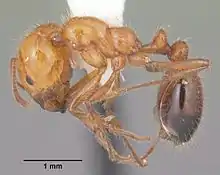Southern fire ant
The southern fire ant (Solenopsis xyloni), also known as the Californian fire ant or cotton ant,[1]:89 is a stinging fire ant native to southern parts of the United States.[2][3][4] Its behaviour is similar to the red imported fire ant (S. invicta), although its sting is less painful. It has a broad and opportunistic diet, and will store seeds in its nest and eat honeydew collected from other insects.[1]:91[5][6]
| Southern fire ant | |
|---|---|
 | |
| Scientific classification | |
| Kingdom: | Animalia |
| Phylum: | Arthropoda |
| Class: | Insecta |
| Order: | Hymenoptera |
| Family: | Formicidae |
| Subfamily: | Myrmicinae |
| Genus: | Solenopsis |
| Species: | S. xyloni |
| Binomial name | |
| Solenopsis xyloni McCook, 1879 | |
The southern fire ant shares its range with the red imported fire ant (S. invicta), the golden fire ant (S. aurea) and S. amblychila. The southern fire ant has the widest distribution of these, occurring from the Carolinas to California, including Georgia, lowland Tennessee, Arkansas, and southern Kansas.[1]
References
- Taber, Stephen (2000). Fire Ants. United States: Texas A&M University Press. p. 88. ISBN 9781603447119. Retrieved 21 September 2016.
- J.A., Weeks; Amanda C. Hodges; Norman C. Leppla. "Fact Sheet: Southern fire ant". Citrus Pests. Identification Technology Program. Retrieved 21 September 2016.
- Coleman; David C. Coleman; Paul F. Hendrix (2000). Invertebrates as Webmasters in Ecosystems. CABI Publishing. p. 222. ISBN 0-85199-394-X.
- Higenkamp, Kathryn (2006). Environmental Health: Ecological Perspectives. United States: Jones and Bartlett Publishers. p. 118. ISBN 9780763723774. Retrieved 21 September 2016.
- https://www.landcareresearch.co.nz/__data/assets/pdf_file/0014/51035/29.pdf
- "Fire Ant Lifecycle". Monday, 16 December 2019
This article is issued from Wikipedia. The text is licensed under Creative Commons - Attribution - Sharealike. Additional terms may apply for the media files.